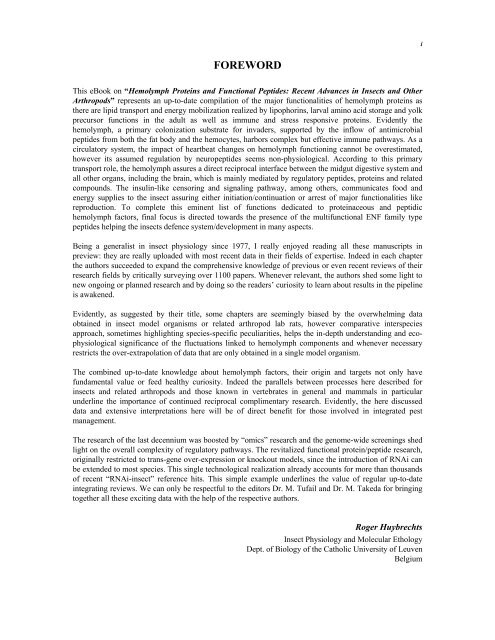chapter 1 - Bentham Science
chapter 1 - Bentham Science
chapter 1 - Bentham Science
You also want an ePaper? Increase the reach of your titles
YUMPU automatically turns print PDFs into web optimized ePapers that Google loves.
FOREWORD<br />
This eBook on “Hemolymph Proteins and Functional Peptides: Recent Advances in Insects and Other<br />
Arthropods” represents an up-to-date compilation of the major functionalities of hemolymph proteins as<br />
there are lipid transport and energy mobilization realized by lipophorins, larval amino acid storage and yolk<br />
precursor functions in the adult as well as immune and stress responsive proteins. Evidently the<br />
hemolymph, a primary colonization substrate for invaders, supported by the inflow of antimicrobial<br />
peptides from both the fat body and the hemocytes, harbors complex but effective immune pathways. As a<br />
circulatory system, the impact of heartbeat changes on hemolymph functioning cannot be overestimated,<br />
however its assumed regulation by neuropeptides seems non-physiological. According to this primary<br />
transport role, the hemolymph assures a direct reciprocal interface between the midgut digestive system and<br />
all other organs, including the brain, which is mainly mediated by regulatory peptides, proteins and related<br />
compounds. The insulin-like censoring and signaling pathway, among others, communicates food and<br />
energy supplies to the insect assuring either initiation/continuation or arrest of major functionalities like<br />
reproduction. To complete this eminent list of functions dedicated to proteinaceous and peptidic<br />
hemolymph factors, final focus is directed towards the presence of the multifunctional ENF family type<br />
peptides helping the insects defence system/development in many aspects.<br />
Being a generalist in insect physiology since 1977, I really enjoyed reading all these manuscripts in<br />
preview: they are really uploaded with most recent data in their fields of expertise. Indeed in each <strong>chapter</strong><br />
the authors succeeded to expand the comprehensive knowledge of previous or even recent reviews of their<br />
research fields by critically surveying over 1100 papers. Whenever relevant, the authors shed some light to<br />
new ongoing or planned research and by doing so the readers’ curiosity to learn about results in the pipeline<br />
is awakened.<br />
Evidently, as suggested by their title, some <strong>chapter</strong>s are seemingly biased by the overwhelming data<br />
obtained in insect model organisms or related arthropod lab rats, however comparative interspecies<br />
approach, sometimes highlighting species-specific peculiarities, helps the in-depth understanding and ecophysiological<br />
significance of the fluctuations linked to hemolymph components and whenever necessary<br />
restricts the over-extrapolation of data that are only obtained in a single model organism.<br />
The combined up-to-date knowledge about hemolymph factors, their origin and targets not only have<br />
fundamental value or feed healthy curiosity. Indeed the parallels between processes here described for<br />
insects and related arthropods and those known in vertebrates in general and mammals in particular<br />
underline the importance of continued reciprocal complimentary research. Evidently, the here discussed<br />
data and extensive interpretations here will be of direct benefit for those involved in integrated pest<br />
management.<br />
The research of the last decennium was boosted by “omics” research and the genome-wide screenings shed<br />
light on the overall complexity of regulatory pathways. The revitalized functional protein/peptide research,<br />
originally restricted to trans-gene over-expression or knockout models, since the introduction of RNAi can<br />
be extended to most species. This single technological realization already accounts for more than thousands<br />
of recent “RNAi-insect” reference hits. This simple example underlines the value of regular up-to-date<br />
integrating reviews. We can only be respectful to the editors Dr. M. Tufail and Dr. M. Takeda for bringing<br />
together all these exciting data with the help of the respective authors.<br />
Roger Huybrechts<br />
Insect Physiology and Molecular Ethology<br />
Dept. of Biology of the Catholic University of Leuven<br />
Belgium<br />
i

















